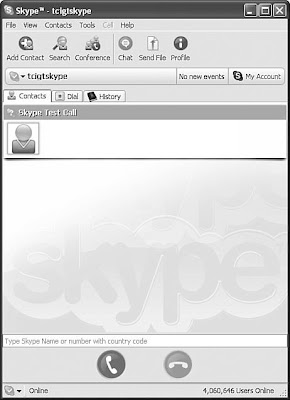 In October 2005, Skype was acquired by eBay, which also owns PayPal. eBay’s goal is to use Skype to enable its buyers and sellers to communicate more effectively and so reduce the “friction” inherent in buying and selling things. Overall, this is good news for Skype and for Skype users. Not only will eBay’s user base be encouraged to use Skype—significantly adding to the number of people already using the program—it gives Skype the backing of an Internet powerhouse that has lots of marketing and financial muscle.
In October 2005, Skype was acquired by eBay, which also owns PayPal. eBay’s goal is to use Skype to enable its buyers and sellers to communicate more effectively and so reduce the “friction” inherent in buying and selling things. Overall, this is good news for Skype and for Skype users. Not only will eBay’s user base be encouraged to use Skype—significantly adding to the number of people already using the program—it gives Skype the backing of an Internet powerhouse that has lots of marketing and financial muscle.
Sunday, June 28, 2009
Skype Trivias #1
 In October 2005, Skype was acquired by eBay, which also owns PayPal. eBay’s goal is to use Skype to enable its buyers and sellers to communicate more effectively and so reduce the “friction” inherent in buying and selling things. Overall, this is good news for Skype and for Skype users. Not only will eBay’s user base be encouraged to use Skype—significantly adding to the number of people already using the program—it gives Skype the backing of an Internet powerhouse that has lots of marketing and financial muscle.
In October 2005, Skype was acquired by eBay, which also owns PayPal. eBay’s goal is to use Skype to enable its buyers and sellers to communicate more effectively and so reduce the “friction” inherent in buying and selling things. Overall, this is good news for Skype and for Skype users. Not only will eBay’s user base be encouraged to use Skype—significantly adding to the number of people already using the program—it gives Skype the backing of an Internet powerhouse that has lots of marketing and financial muscle.
A brief history on Skype
 Skype is not the first P2P software to be made widely available via the Internet and to achieve mainstream status. Indeed, the people who founded Skype, Niklas Zennström and Janus Friis, are the same people who created the P2P file sharing program Kazaa, which is the most downloaded (at 363 million as of September 2004) software In the history of the Internet. Skype clearly has something of a\ pedigree.
Skype is not the first P2P software to be made widely available via the Internet and to achieve mainstream status. Indeed, the people who founded Skype, Niklas Zennström and Janus Friis, are the same people who created the P2P file sharing program Kazaa, which is the most downloaded (at 363 million as of September 2004) software In the history of the Internet. Skype clearly has something of a\ pedigree.Skype was founded in 2002, but the domain names Skype.com and Skype.net weren’t registered until April 2003. August 2003 saw the release of the first public beta, or trial, version of the Skype softphone (often also referred to as the Skype client). In June 2004, Skype introduced its first fee-based service, SkypeOut, which enables Skype users to call regular phone numbers all over the world at very low rates (as low as $0.021 per minute). SkypeIn, which is a fee-based service that allows people to call Skype users from regular phones, debuted in March 2005. Skype continues to add new features and services at a rapid pace.
What SKype can Do?
 Skype-to-Skype calls are free, as are video calls, chat, and file transfers. So even without becoming a fee-paying Skype subscriber, you can do an awful lot for free!
Skype-to-Skype calls are free, as are video calls, chat, and file transfers. So even without becoming a fee-paying Skype subscriber, you can do an awful lot for free!Skype’s fee-based subscription services enhance Skype so that you can also make calls to, as well as receive calls from, regular and mobile phones. For additional fees, you can add on voicemail, custom ringtones, and other optional services.
Skype’s phenomenal success, in large part, is due to the rich—and growing—feature set you get simply by installing Skype on your computer. Also, Skype has received a good deal of praise for the simplicity of its user interface and its ease of use, which have done much to contribute to its success. The Skype softphone runs in a small window on your PC, with a graphical interface that is surprisingly easy to navigate given the number of features it supports, as the following figure illustrates. As mentioned previously, you can augment Skype’s basic feature set by subscribing to any of the following fee-based services:
- SkypeOut: Make calls to regular and mobile phones.
- SkypeIn: Receive calls from regular and mobile phones.
- Voicemail: Record voice messages from callers.
- Skype Zones: Use all of Skype’s services while traveling.
- Personalise Skype: Add custom ringtones and pictures to the
- Skype softphone.
- Skype Control Panel: Manage Skype subscription services for a group of Skype users (mostly of interest to business users of Skype).
In contrast to many regular and mobile phone plans, which are typically quite inflexible about what features are included with your service plan, with Skype you only have to pay for those features you want. Plus, Skype doesn’t require you to sign any complex or longterm contracts. That’s right: you can cancel anytime—often receiving a refund for unused services. Try that with your phone company or mobile carrier!
Subscribe to:
Posts (Atom)
